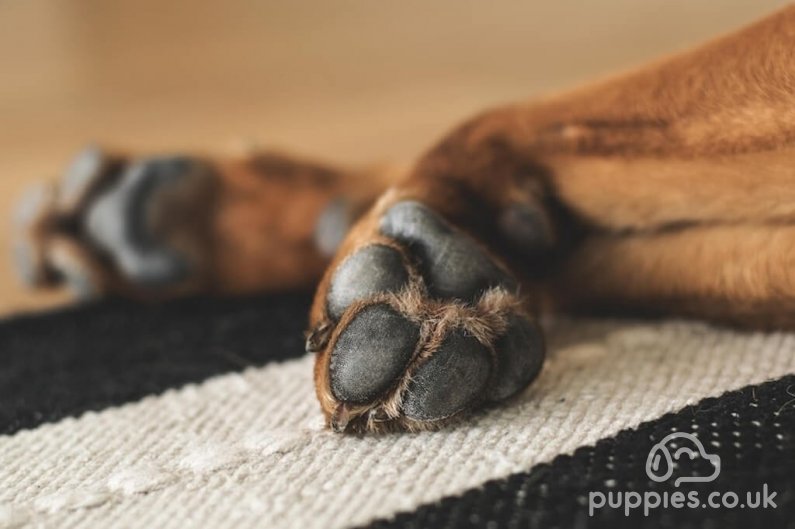How to Deal with Your Dog’s Paw Infections

It is normal for your dog to lick its paws because this is a cleaning ritual, as long as it is not done in an excessive manner or the dog doesn’t appear to be in pain while doing it. Also, it is not an issue if you notice small cracks on the surface of the paws, as you inspect them. Minor scratches usually heal by themselves and do not create any kind of problems to your dog.
However, there are situations in which paws do get infected, irritated, itchy, and red, causing your dog physical discomfort and even pain. If you notice your dog munching on its paws and whining while doing so, you should immediately take a look at its paws. There are quite a few factors that can lead to paw infections.
Also, believe it or not, there are some dog breeds that are more prone to developing certain types of paw infections than others. Due to the fact that a paw infection can appear at any time during the year, when you are home, or traveling with your pet, you should learn all about it and know how to deal with such episodes in an effective manner. A paw infection can prevent the dog from walking right, not to mention that is quite uncomfortable, especially if we are talking about constant itchiness.
Factors that can trigger a paw infection
- Yeast or fungi
Although it may seem hard to believe, yeast can grow in an exaggerated manner on your dog’s paws, causing discomfort. When it comes to yeast-related infections, the problem may be more serious than your dog’s paws. According to PetMD, a dog may show fungal infections on its paws, but you may actually have to deal with an overall skin problem. So, it would be recommended to check the dog’s skin in various parts of its body, to see if you notice any issues.
An infection with fungi will make the dog lick its paws rather often. Thus, your companion’s constant interest in licking its paws should ring a bell for you. Red nail beds are another sign of this kind of infection when you closely inspect the paws. Itchiness, redness, and even discharges can be seen in some cases. The reason yeast develops uncontrollably can be due to a food allergy, an allergy triggered by an environmental factor, or skin problem like atopic dermatitis.
- Infections caused by bacteria
It is worth knowing that both bacteria and yeast are organisms that naturally live on the dog’s paws. But, when they multiply too much, problems emerge. When do bacteria develop beyond control? This usually happens when the dog’s immune system is compromised by a health problem, which makes it unable to keep the bacteria population in control. So, when paw infections are caused by bacteria, there could be a secondary health issue bothering your dog as well.
This type of paw infection manifests through redness, itchiness or pain, swelling, and, in more severe cases, abscess. The dog will also lick and bite its paws more frequent than it is normal. If you notice any of the previously mentioned symptoms, you should seek treatment as soon as it is possible, as this condition creates quite a lot of discomfort.
- Tears or cuts on the paws
Just like in the case of humans, when skin is cut or torn, a breach for bacteria to enter the organism is created. This is why a cut or torn paw should be treated immediately before it turns into a breeding pool for germs and bacteria.
Dogs can be quite diplomatic when it comes to their injury, so it would be a good idea to inspect the dog’s paws after each walk or adventure in the outdoors. A sharp rock, a thorn, or debris found on the ground can injure the dog’s paws. So, not seeing blood on the floor doesn’t mean that there isn’t any cut to look after. Your dog may lick its paws and clean the blood, but the injury is still there and it can accumulate dust and harmful particles.
The wound should be properly cleaned and disinfected. Using a diluted antiseptic, such as Betadine, the kind everyone has lying around the house, is a good way to do this. Once the wound is cleaned, you will have to apply a sterile bandage over the wound. Make sure it is tight enough so that it won’t fall off as your dog moves and walks. Of course, don’t exaggerate when tightening it, as you still want blood running through your dog’s paws.
- Grass seeds puncturing the paws
While there’s nothing better than running with your dog through the grass, the tiny seeds produced by plants from the grass family can cause more trouble than you think. Long grass or barley grass, in particular, produce seeds that can be very uncomfortable for your dog. Also, if the seeds are not removed from your dog’s paws, they can easily lead to an infection, due to their sharp ends.
Again, take a good look at your dog’s paws after each walk. This is something a dog owner should do on a daily basis, regardless of the season. Inspecting and cleaning the dog’s paws after each outdoor adventure can save you from a lot of trouble.
Recipes for baths that can soothe your pet’s paws
If your dog has itchy, inflamed, or irritated skin, you can use several natural ingredients to come up with a soothing bath for the dog’s paws. These baths are especially useful for dogs that are prone to food allergies, as they can offer a quick solution when your dog is having trouble with its diet. However, even if we are talking about natural ingredients, it is not recommended to bathe your dog’s paws if they present cuts, thorn nails, or open wounds.
- One or two tablespoons of baking soda added to a gallon of lukewarm water can be very soothing for itchiness and inflammation. You can soak your pet’s paws in this water for a few minutes after each walk. It will reduce the dog’s need to lick and chew on its paws.
- Add a few cups of ground, natural, and unsweetened oats to warm water in the bathtub and dissolve them a little. The level of the water should allow only for the paws to soak in, so you don’t need to fill the tub. Put the dog inside the bathtub and allow it to stand or even lie in this water for about 10 minutes. The natural oils contained by the oats will soothe cracked, dry, or inflamed paws.
- One cup of Epsom salts for every gallon of water can help you come up with a bath that will restore your dog’s natural pH in the paws. This solution will kill harmful bacteria and will help restore the level of good bacteria. 10 minutes spent in this bath will help with itchiness and inflammation.
When it’s time to see the veterinarian
While it is true that many paw issues can be managed at home, you need to know when it’s time to seek the assistance of a veterinarian. For example, in the case of bacterial or yeast infections, the vet may need to take a sample from the dog’s paws in order to recommend the best treatment. So, there are a couple of signs that tell you it’s time to take your companion to be seen by the vet.
- The paw presents bleeding that doesn’t seem to stop or oozing is noticeable;
- Sores on the surface of the paws are also not a good sign;
- When the base of the nails present a sort of crust-like formation;
- When the paws present calluses of significant sizes. These calluses can make the toes of the paw to move in the wrong direction, causing tenderness and discomfort;
- Cracks in the paws that are deep, causing bleeds and oozes.
It is not pleasant to see that your best friend is in pain or has to deal with constant itching, but it is worth knowing that most paw infection can be easily treated with a bit of care. However, the best way to avoid health problems when it comes to your companion is to get a puppy with a great genetic condition, from a reliable dog breeder. Charlotte Dog Club is dedicated to connecting future dog owner with the healthiest and happiest puppies, provided by responsible dog breeders only. Visit the website and find the ideal puppy for you and your family.












